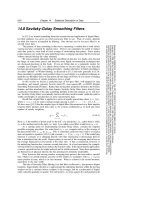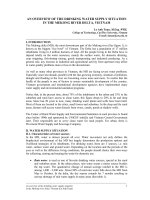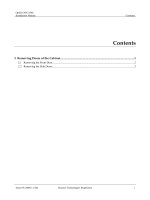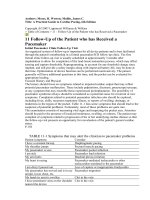Tài liệu APPENDIX Description of the Extraordinary Measures pdf
Bạn đang xem bản rút gọn của tài liệu. Xem và tải ngay bản đầy đủ của tài liệu tại đây (23.55 KB, 5 trang )
1
APPENDIX
Description of the Extraordinary Measures
Secretaries of the Treasury in both Republican and Democratic administrations have used
their authority to take certain extraordinary measures in order to prevent the United States from
defaulting on its obligations as Congress deliberated on increasing the statutory debt limit. Four
of these extraordinary measures are available at this time. The other measures that have been
taken in the past are either unavailable or of limited use.
The extraordinary measures currently available are: (1) suspending sales of State and
Local Government Series Treasury securities; (2) determining that a “debt issuance suspension
period” exists, which permits the redemption of existing, and the suspension of new, investments
of the Civil Service Retirement and Disability Fund and the Postal Service Retirees Health
Benefit Fund; (3) suspending reinvestment of the Government Securities Investment Fund and
(4) suspending reinvestment of the Exchange Stabilization Fund. These measures are described
in more detail below.
These extraordinary measures, all of which have been employed during previous debt
limit impasses, have the effect of creating or conserving headroom beneath the debt limit. These
measures are limited and therefore can postpone only briefly the need for an increase in the
statutory debt limit. On average, the public debt of the United States is increasing by
approximately $100 billion per month (although there are significant variations from month to
month). In total, the extraordinary measures currently available free up approximately $200
billion in headroom under the limit, as described below.
1. State and Local Government Securities
The Treasury Department has authority to suspend its issuance of State and Local
Government Series Treasury securities (SLGS). This however, is a limited measure that does not
create headroom under the debt limit.
SLGS are special purpose Treasury securities issued to state and local government
entities. In ordinary times, the Treasury Department issues SLGS to state and local governments
to assist these governments in complying with Federal tax laws when they have cash proceeds to
invest from their issuance of tax exempt bonds. When Treasury issues these securities, they
count against the debt limit.
There is no statutory or other requirement for the Treasury
Department to issue SLGS; they are issued in order to assist state and local governments, and
Treasury may suspend SLGS sales as the debt subject to limit approaches the debt limit.
This action does not free up headroom under the debt limit. Rather, it conserves
headroom (i.e., it eliminates increases in debt that would count against the debt limit if issued).
Approximately $4 to $17 billion in SLGS is issued per month, although this amount is subject to
substantial variation from month to month. Some state and local governments issuing certain
types of new debt after the SLGS sales are suspended will have to invest the proceeds in
alternative assets in order to remain in compliance with tax law.
2
2. Declaring a “Debt Issuance Suspension Period”
Once the debt limit has been reached, Treasury has authority to declare a “debt issuance
suspension period” which permits Treasury to take actions regarding investments under the Civil
Service Retirement and Disability Fund (CSRDF) and the Postal Service Retiree Health Benefits
Fund (PSRHBF).
a. Declaring a “Debt Issuance Suspension Period”
The CSRDF provides defined benefits to retired and disabled Federal employees covered
by the Civil Service Retirement System. The fund is invested in special-issue Treasury
securities, which count against the debt limit. Congress has given Treasury statutory authority to
take certain actions in the event of a debt limit impasse. Specifically, the statute authorizes the
Secretary of the Treasury to determine that a “debt issuance suspension period” exists and, once
he has done so, Treasury can (1) redeem certain existing investments in the CSRDF, and
(2) suspend new investment.
The Secretary of the Treasury does not have unlimited discretion to declare a debt issuance
suspension period. Under the statute that governs the CSRDF, the term “debt issuance
suspension period” means the period of time that the Treasury Secretary determines that
Treasury securities cannot be issued without exceeding the debt limit. The determination of the
length of the period must be based on the facts as they exist at the time.
Declaring a debt issuance suspension period is a limited measure that relates only to the
CSRDF; it has no impact on any other investments or any other portion of the debt. Moreover, it
only provides limited additional time. A two-month debt issuance suspension period, for
example, would free up approximately $12 billion in headroom.
1
During a debt issuance suspension period, civil service benefit payments would continue to
be made as long as the United States has not yet exhausted the extraordinary measures. Once the
extraordinary measures have been exhausted, however, the U.S. Government will be limited in
its ability to make payments across the government. After the debt limit impasse has ended, the
statute provides that the CSRDF is to be made whole.
2
Therefore employees and retirees are
unaffected by these actions.
1
The statute governing the CSRDF gives Treasury authority to redeem existing Treasury securities held by the
CSRDF in an amount up to the amount of civil service benefit payments authorized to be made from the CSRDF
during the debt issuance suspension period. 5 U.S.C. § 8348(k). Treasury makes approximately $6 billion in civil
service benefit payments from the CSRDF each month. Therefore, declaring a two-month debt issuance suspension
period would allow Treasury to redeem approximately $12 billion of the Treasury securities held by the CSRDF,
freeing up approximately $12 billion in headroom. The statute also authorizes Treasury to suspend new investments
by the CSRDF during a debt issuance suspension period. The CSRDF receives approximately $2 billion in new
employer and employee contributions each month. Therefore, during each month of a debt issuance suspension
period, approximately $2 billion in headroom that would otherwise be used is conserved.
2
After the debt limit impasse has ended, Treasury is required to put the CSRDF investment portfolio into the
position it would have been in if the impasse had not occurred, and to restore lost interest on the next regularly
scheduled interest payment date on the Treasury securities held by the CSRDF.
3
b. One-time measure available on December 31
The same statute that authorizes Treasury to redeem existing investments during a debt
issuance suspension period also authorizes Treasury to suspend new investments by the CSRDF
during such a period. On December 31, there is an interest payment of approximately $16 billion
scheduled to be made to the fund. Ordinarily, this interest payment would be invested. But with
the investment suspension authority available, Treasury may suspend the investment of the
interest. Suspending the investment would free up approximately $16 billion in headroom. In
addition, the Postal Accountability and Enhancement Act of 2006 provides that investments in
the PSRHBF shall be made in the same manner as investments for the CSRDF. Investing the
PSRHBF in the same manner as the CSRDF would free up approximately $1 billion in
headroom.
3
It should be understood that this suspension of reinvestment that frees up headroom
is a one-time measure: it is only available on December 31.
3. G Fund
Once the debt limit has been reached, Treasury may also suspend the daily reinvestment
of the Treasury securities held by the Government Securities Investment Fund (G Fund) of the
Federal Employees’ Retirement System Thrift Savings Plan.
The G Fund is a money market defined-contribution retirement fund for Federal
employees. The fund is invested in special-issue Treasury securities, which count against the
debt limit. The entire balance matures daily and is ordinarily reinvested. Congress has granted
Treasury the statutory authority to suspend reinvestment of all or part of the balance of the
G Fund when the Secretary determines that the fund cannot be fully invested without exceeding
the debt limit.
4
Using this measure immediately frees up headroom under the debt limit. Because the
G Fund balance is approximately $156 billion, using this measure can immediately create up to
approximately $156 billion in headroom.
During the period of the investment suspension, payments from the G Fund continue to
be made as long as the United States has not yet exhausted the extraordinary measures. Once the
United States has exhausted the extraordinary measures, however, the U.S. Government will be
limited in its ability to make payments across the government. After the debt limit impasse has
ended, the G Fund is made whole.
5
Therefore participants in the Thrift Savings Plan who
contribute to the G Fund are unaffected by the actions described above.
3
On December 31, there is an interest payment of approximately $1 billion scheduled to be made to the PSRHBF.
Ordinarily, this interest payment would be invested. But with the investment suspension authority available,
Treasury may suspend the investment of the interest. Treasury is not scheduled to make any payments from the
PSRHBF in the near future. Therefore, declaring a debt issuance suspension period would not allow Treasury to
redeem Treasury securities held by the PSRHBF.
4
5 U.S.C. § 8438(g).
5
Treasury is required to restore lost interest on the next business day.
4
4. Exchange Stabilization Fund
Treasury may also suspend the daily reinvestment of Treasury securities held by the
Exchange Stabilization Fund (ESF).
The ESF has a number of uses, including purchasing or selling foreign currencies. A
portion of the ESF is held in U.S. dollars, and the dollar-balance of the ESF is invested in
special-issue Treasury securities. The entire dollar-balance matures daily. There is no
requirement that the Treasury Department invest the ESF, so Treasury may suspend the
investment of the dollar-balance of the ESF during a debt limit impasse.
Suspending the daily reinvestment of the dollar-balance of the ESF immediately frees up
headroom under the debt limit. Because the dollar-balance of the ESF is approximately $23
billion, this would create up to approximately $23 billion in headroom.
After a debt limit impasse, the interest lost by the ESF is not restored: there is no existing
authority to reimburse the ESF for lost interest during the period that the dollar-balance is not
invested.
* * *
As described above, these four extraordinary measures can free up approximately $200
billion in headroom.
Other Measures Used in the Past Are No Longer Available or of Limited Use
The other measures that have been used in past debt limit impasses in order to postpone
the date by which the debt limit needed to be increased are either not available or of limited use.
First, although in the past Treasury Secretaries have suspended the issuance of U.S.
savings bonds to the public, doing so now would be of little benefit. Suspending the issuance of
U.S. savings bonds would not free up any headroom under the debt limit. As is the case with
suspending sales of SLGS, suspending the sales of savings bonds would only eliminate increases
in debt that would count against the debt limit if the securities were issued. Moreover,
suspending such sales conserves very little headroom.
6
Second, measures relating to the Federal
Financing Bank (FFB) are of limited use.
7
Third, a measure previously used, involving the
calling in of cash that Treasury kept on deposit at banks, is no longer available: Treasury no
6
Sales of savings bonds increase the amount of debt by less than $220 million per month on average.
7
In the past, Treasury was able to free up headroom under the debt limit by entering into multi-step exchange
transactions with FFB and the CSRDF, swapping obligations that do not count against the debt limit for an equal
amount of Treasury securities held by the CSRDF that do count against the debt limit. In each case, FFB used the
Treasury securities that it received from the CSRDF to pay down its borrowings from Treasury. Treasury
extinguished the Treasury securities received from the FFB to create headroom. The potential to use such an
exchange transaction is of limited use at this time because FFB has a limited amount of obligations available to
exchange.
5
longer keeps these balances.
8
Finally, Congress has in the past provided one-time tools in the
midst of a debt limit impasse;
9
those authorities expired nearly 17 years ago.
Asset Sales
Although the U.S. Government owns other assets, such as gold, there are prudential or
legal limitations on its ability to sell these assets. Selling the Nation’s gold to meet payment
obligations would undercut confidence in the United States both here and abroad, and would be
extremely destabilizing to the world financial system. With respect to financial assets acquired
as part of the response to the financial crisis in 2008 and 2009, Treasury has already sold most of
these assets and is conducting an orderly wind-down of the remaining investments. A fire sale of
these assets, however, would be disruptive and would harm taxpayer interests. Similar
considerations argue against fire sales of other public assets. And, in any event, asset sales
would not generate sufficient revenue to make an appreciable difference in when the debt limit
must be raised. Finally, for both legal and practical reasons, sale of the government’s portfolio
of student loans is not feasible. For these reasons, Secretaries of the Treasury of both parties
have concluded that asset sales are not a prudent or viable alternative to increasing the debt limit.
8
In the past, Treasury had an ability to increase its cash balance without increasing debt by calling in the non-
interest-bearing balances that Treasury formerly kept on deposit at banks to compensate them for fiscal services they
provided to Treasury. That option is no longer available because Treasury discontinued keeping those
“compensating balances” after Congress appropriated funding to Treasury in 2004 to pay directly for fiscal services.
9
Specifically, in 1996, in order to enable Treasury to pay the March 1996 Social Security benefits, Congress passed
legislation that permitted Treasury to issue a limited amount of Treasury securities that were temporarily excluded
from being counted against the debt limit. In addition, Congress passed legislation that temporarily excluded from
being counted against the debt limit the new Treasury securities that Treasury issued to federal trust funds in March
1996 to invest new trust fund receipts and to reinvest the proceeds of maturing trust fund investments. Those
exclusions from the debt limit expired on March 30, 1996.









